16/04/2017 Arado Ar 234B-2 Luftwaffe, FROG Models
Although only a few years older, those Fiat biplanes look really archaic next
to the Arado Ar 234 “Blitz”, the first and only operational jet bomber aircraft
in WWII. Orginally designed as a high-speed reconnaissance aircraft, the Ar 234
was build in low numbers and only saw limited action in the closing stages of
the conflict.
Massively delayed because of engineering difficulties with the then-new jet
engines, the original prototypes took off from a jettisonable start trolley and
landed on skids mounted below the fuselage and engines. This would have save the
weight of an retractable gear, however it was deemed that this was not practical
in real-life operations, and later prototypes were equipped with an conventional
tricycle landing gear. Jet aircraft needed a longer take-off run, to counter
this problem two jettisonable rocket pods were installed under the wings (the
so-called RATO packs). They were detached shortly after take-off and parachuted
back to the ground, were they could be collected and re-used.
Only one version of the Ar 234 reached operational status, the Ar 234 B-2
variant, used in a dual role as bomber and reconnaissance aircraft. As a recon
plane, it was so fast that it was virtually impossible for the Allies to
intercept; therefore no offensive or defensive weaponry of any kind was ever
installed on operational aircraft; however this was planned for later versions.
In fact, the Ar 234 was the last German airplane to fly over England in April
1945. It was only used for very few bombing missions by it´s single operational
squadron, KG 76. While it was still fast, carrying bombs slowed down the “Blitz”
considerably (every payload had to be installed externally). In reality, the Ar
234 stayed grounded most of the time, with lack of fuel and spares and the
collapsing German infrastructure at the end of WWII. Most proposed versions of
the Ar 234 never left the drawing board, although a four-engine version, the Ar
234 C, was completed but not used operationally. It may only be flown once.
Today, only one Ar 234 B-2 remains, fully restaurated and on display at the
Steven F. Udvar-Hazy Center next to Washington-Dulles airport.
This Ar 234 B-2 was flown by Oblt. Werner Muffey of the “Sonderkommando
Sperling” in late 1944, Sonderkommando Sperling was an experimental Luftwaffe
Unit created for the Ar 234, specalized in reconnaissance missions. Not much is
known about their operations, although recon flights over England, France and
Italy were conducted. Muffey´s Ar 234 was the only one with some sort of nose
art, a rare sight for Luftwaffe planes – it showed a jet-propelled bird.
This kit is an really old one, the original boxing of British manufacturer FROG
from 1976, shortly before they went out of business. It is comparable to Airfix
kits of the time, relative simple, rough details, but a lot of building options
(B and C versions). Overall a nice build, very nostalgic in a way, of course you
cannot have high expectations with this old mould – I added a few cockpit
details, and that’s it. Not surprisingly, the decals were unusuable after 40+
years so I used aftermarket decal from Peddinghaus.



Original photo of this aircraft:

08/04/2017 Fiat CR.32 Regia Aeronautica, Italeri
In 1939, when other Air Forces around the world had already phased out
obsolete biplanes, the Regia Aeronautica (Royal Italian Air Force) did not
hesitate to introduce a new model, the Fiat CR.42 (seen on the first page). It
was the successor to the Fiat CR.32, shown here, the standard Italian Fighter
airplane of the 1930s and still the most numerous type in the Regia Aeronautica
fleet at the outbreak of WWII.
Italian Air Doctrine, basically unchanged since WWI, preferred maneuverability
and aerobatics above everything else, and monoplane designs were primarly
selected for new bomber designs, but at first not necessarly for new fighter
aircraft. Without a doubt, the CR.32 (CR stands for the main aircraft designer,
Celestino Rosatelli) was an excellent aerobatic aircraft, and well liked by the
pilots. Introduced in 1933, it was the most advanced biplane design of its time
and proved to be valuable in the Spanish Civil War, were it was used by the
Italian “Mercenary” force supporting the Nationalists. Impressed by the success
in Spain, Italian Aircraft Designers still believed strongly in the biplane
design, a costly mistake that slowed down progress of modern fighter designs
significantly, and left Italy way behind the German or British aviation industry
at the time.
In the early stages of WWII, the CR.32 was used in the North African and
Mediterranian campaigns, and although clearly outdated then, the opposing Royal
Air Force pilots were warned by their commanders that these biplanes were still
considered a threat, as a skilled pilot could easily outturn Hurricanes and
Spitfires, and was able to turn the tables in a low-speed dogfight.
Nevertheless, the superior agility of the CR.32/42 aside, the time of the
biplane was over: It was too slow, had inadequate pilot protection (open cockpit
!), and in the case of the CR.32/42, lacked firepower. The last CR.32 were
retired from active duty in 1941 and relegated to training units. Today, only
two CR.32 are remaining, one in an museum in Rome and one in Madrid.
This CR.32 of the 163. Squadriglia Autonoma was based in Roda, Corfu in Greece,
1940. It had the typical camouflage used by many Italian Aircraft in the
Mediterranian theatre.
This kit is from a new Italeri release, but it´s basically an old 1970s mould
from Supermodel. Italeri has updated the tooling, and it´s really good, with
decent detail and good fitting. A pleasant surprise and a nice little model with
7 different decal options, which is quite impressive. It certainly looks good
next to the “sister aircraft”, the CR.42.


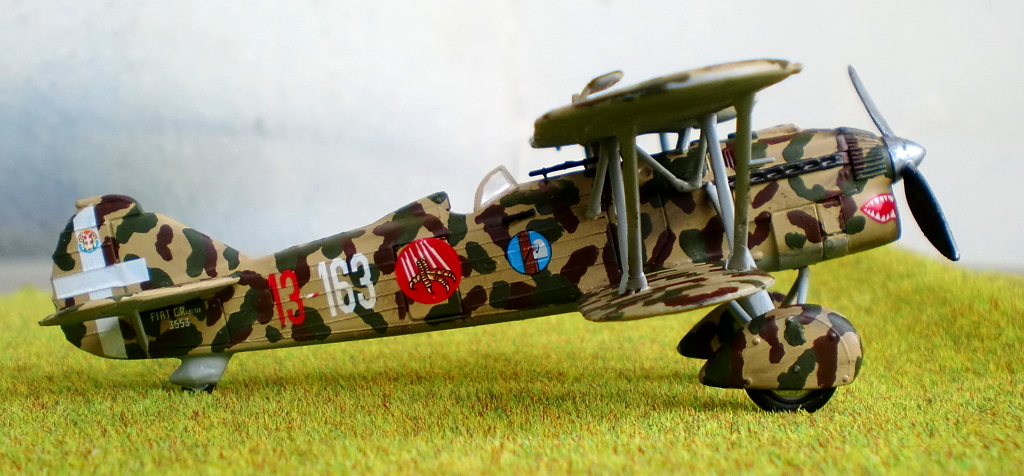
18/03/2017 Messerschmitt Bf 109B-2 Legion Condor, Heller
With almost 34.000
units build, the Messerschmitt Bf 109 is the most produced fighter aircraft in
history, and was the Luftwaffe´s standard fighter between 1937 and 1945.
Although supplemented by the superior Focke Wulf Fw 190 in later years, the Bf
109 remained the backbone of the Luftwaffe, and almost all top Luftwaffe aces
scored the majority of their victories in the Bf 109. One of the challenges of
the Messerschmitt Engineers was to keep the aircraft up to date over the
years, introducing a lot of refinements considering the engine, avionics and
arnament, although the basic airframe of the Bf 109 was not heavily modified.
This led to a lot of different versions and sub-versions, namely the A- to G-
variants and the final K-version, with the A to D versions produced before the
outbreak of WWII.
This Bf 109 here is an early Bf 109 B-2 version, first flown in 1937. Spotting
features of the B-version are a very different cowling design compared to
later versions, with a large radiator under the belly (the A-D versions were
powered by Junkers Jumo Engines, all later ones by Daimler-Benz), and a
two-blade propeller. One of the most advanced fighters of its time, it first
saw operational use with the Condor Legion in the Spanish Civil War, where it
was superior to every other fighter it encountered – and achieving air
superiority for the Nationalists, which was a major step to victory for Franco
and his troops.
This Bf 109 B-2 of Jagdgruppe 88 was flown by Hauptmann Gotthard Handrick
(1908 – 1978), the squadron leader of this unit. Handrick gained five
victories in Spain and 10 victories in WWII, where he was assigned to
different squadron commands. The most interesting part of his biography is
that he was an athlete and Olympic Medal winner before joining the Luftwaffe.
He won the Gold medal in modern pentathlon at the Olympic Games in Berlin 1936
(and is, to this day, the only male German athlete to win this discipline).
The spinner of his Bf 109 in Spain was decorated with the Olympic Rings,
unfortunately not included with the decals.
When it comes to the Bf 109 in 1/72 scale, the are a lot of kits to choose
from, but the early A-D versions are somewhat harder to find. I didn´t want to
tackle a Czech short run kit this time, so I selected the rather old tooling
from Heller, dating to the 1970s (still avaiable in newer reboxed runs). A
mediocre fit and soft plastic is what to expect from a Heller kit from this
era, but what surprised me the most are the decals, especially the ones
applied to the fuselage, as they are plainly to big (the reg numbers and the
top hat are more like 1/48 scale !). I did use them anyway, although there are
up-to-scale aftermarket decals avaiable, but they cost as much as the entire
kit !

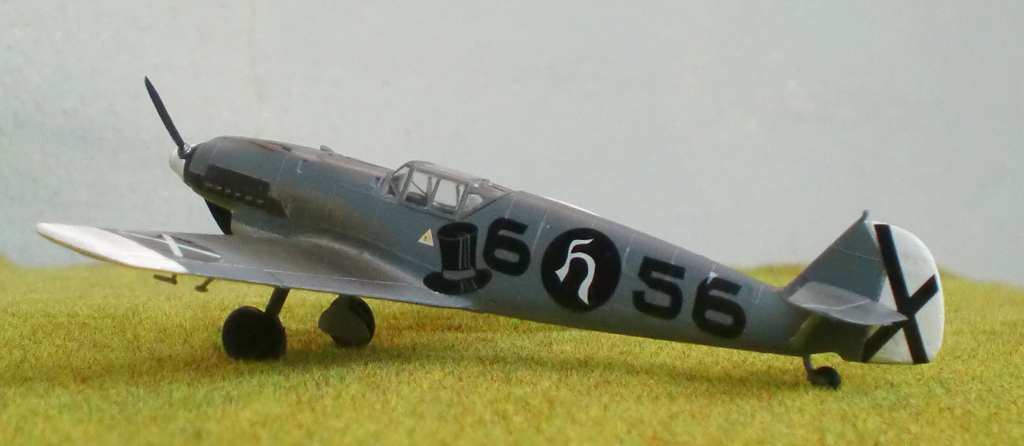

Gotthard Handrick (left), Olympic Medal Winner & Fighter pilot

26/02/2017 Nakajima Ki-84 Hayate Japanese Army Air Force, Hasegawa
The
Nakajima Ki-84 Hayate (allied codename „Frank“) was one of the most advanced
fighters of the Imperial Japanese Army to see large-scale operations during
the later part of WWII. The Ki-84 was developed from the Ki-43 “Oscar”, the
standard fighter aircraft the Army, and adressed several issues of the Ki-43
that needed to be corrected; for example lack of armored tanks and pilot
protection; firepower and high-altitude performance. The final result, the
Ki-84, was first flown in 1943 and although the aircraft had great potential,
it could never really be fully exploited due to the deterioration of the
Japanese industrial capacities.
Powered by the compact, but powerful (up to 2000hp) Nakajima Ha-45 Homare
radial engine, the Ki-84 could reach speeds up to 420mph, making it the
fastest aircraft of the Army Air Force. However, the complicated Ha-45 engine
was hard to maintain and lack of high octane fuel hampered engine performance.
With the Japanese aviation industry running out of resources, later production
models of the Hayate suffered from poor build quality and low-quality metal
alloys; accidents due to collapsing landing gears were quite common. Above
all, the Japanese lacked experienced pilots to unleash the potential of this
high-altitude interceptor.
However, as test flights by the US Air Force after the war showed, if the
aircraft was in good shape and powered by high octane fuel, it was able to
keep up with the best Allied aircraft of the time; even outperforming the P-47
and P-51 at certain altitudes. One Ki-84 remains and was restored to flying
condition in the USA in the 1970s, it was later transferred to Japan and is
now on static display at the Chiran Air Museum in Kagoshima.
This Ki-84 has the markings of the 2nd Chutai (Squadron) on the 29th Sentai
(Fighter Group) based a Taiwan in 1945. This kit is one of the older toolings
from Hasegawa. I build it out of the box with no modifications. A simple and
hassle-free build, it is not that detailled but this is quite common for older
kits.
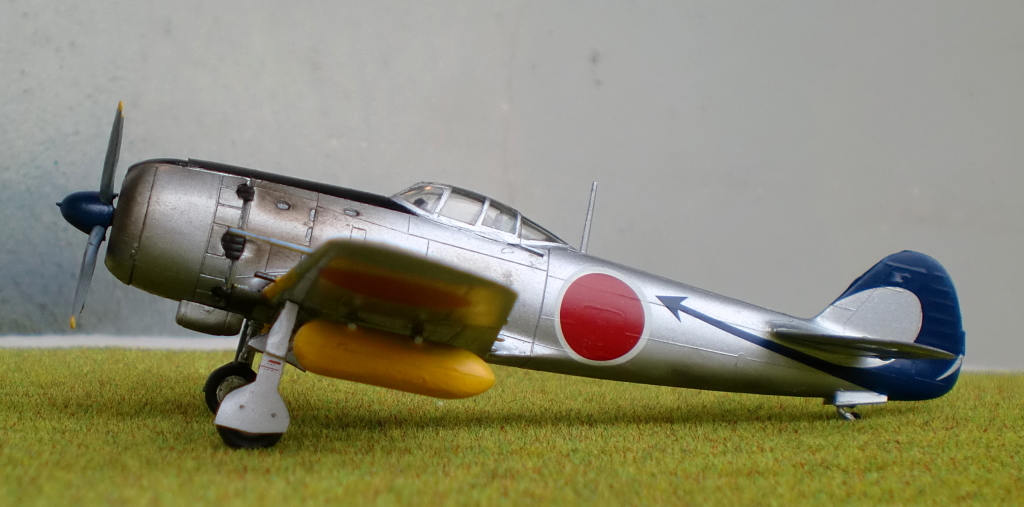


The only remaining Ki-84:

08/02/2017 Heinkel He 70 Luftwaffe, ICM Models
Speaking of beautiful
planes, one of the most elegant aircraft of it´s time was surely the Heinkel
He 70 “Blitz” (Lightning). Designed as a fast passenger and mail aircraft,
it was a direct answer to the Lockheed Orion, the most advanced airliner of
the early 1930s. Ernst Heinkel, always obsessed by high-speed aircraft, and
his design team, the Günther twin brothers, responded to a request of
Deutsche Lufthansa to create the fastest avaiable passenger aircraft, able
to outperform the American rivals (who, at that time, had advantages in
powerful engine designs). The Günther Brothers designed a streamlined
low-wing monoplane, with flush rivets for a smooth surface, elliptical wings
and a rectractable landing gear (the first of its kind used in Europe).
Carrying two crew and four passengers, the aircraft was powered by an BMW VI
inline engine and made its maiden flight in 1933.
All the attention to aerodynamic details payed off, and with a top speed of
224 mph, it was faster than almost all military planes of that time, and the
fastest passenger aircraft in service in the mid-1930s, only outperformed by
experimental racing aircraft. Lufthansa used it extensively on German
domestic routes, but soon required a bigger aircraft, and Heinkel developed
the He 111 (later developed into the German standard bomber of WWII), the
basic shape of this aircraft very similar to the He 70. However, the
potential of the He 70 was still not completely discovered, tests in the UK
with British-made engines showed that the aircraft could reach speeds up to
290mph, a fact that frustrated Heinkel quite a lot, as German engine
development was still lacking in the 1930s, and could never really catch up
until the end.
With the emergence of the Luftwaffe in 1936, a military development
programme of the He 70 was set in place, two versions were planned, a
long-range fast reconnaissance aircraft and a light bomber. The light bomber
project was never put into production, but the reconnaissance version, the
He 70 F-2, saw combat use during the Spanish Civil War, were it was used by
the Condor Legion for the Nationalist fraction. However, the He 70 was not
designed as a military aircraft and had serious shortcomings in this role:
for example, weak armor and defensive weaponry and a high fire risk (parts
of the fuselage were made with a Magnesium alloy that could catch fire
easily, a deadly risk when under enemy fire). Consequently, the He 70 was
phased out fairly soon and was primarly used as a recon and
transport/liasion aircraft in the early days of WWII.
This Heinkel He 70 F-2 CF+BF was used by the Stab (squadron command) of JG2
as a reconnaissance and transport aircraft in 1940. JG2 “Richthofen” was
named after the WWI ace and was an elite Luftwaffe squadron that was
primarly engaged on the Western front, participating in the Battle of
Britain. The last He 70 were retired by the Spanish Air Force in 1954.
Unfortunately no aircraft survives.
This He 70 F-2 is from Ukranian manufacturer ICM, and as I expected, was a
rather tough but fun kit. A little bit overcomplicated, but this seems to be
fairly normal with these kind of kits, as you have to take the short-run kit
approach for this. This is not Tamiya for sure. But I liked it a lot, the
subject is such a great looking airplane.



He 70 in Lufthansa Service, ca. 1935:

21/01/2017 Vought F4U Corsair US Navy, Tamiya
Although designed as a
carrier-based fighter aircraft, the Vought F4U Corsair spend the early years
of its service time on land – a few design problems made it problematic for
carrier use, and the US Navy relied on the F6F Hellcat as their top-rated
carrier aircraft. First flown in 1940, the Corsair was the first Navy aircraft
to exceed a speed of 400 mph, thanks to the powerful Pratt & Whitney Double
Wasp Radial engine, one the most powerful aircraft engines (2000 hp) at the
time. The powerful engine required a large propeller, the largest one
installed on a single-engine aircraft, and for the needed ground clearance, an
inverted gull wing design was chosen. This was the distinctive look of the
Corsair.
However, during carrier trails, it was discovered that the right wing would
stall before the left one on slow carrier landing approaches, making landings
extremly dangerous. Also, due to faulty shock absorbers, the aircraft would
bounce and rebound on hard landings and eventually get airborne again and
potentially out of control. It took some time to fix these issues, and in the
meantime the Corsair was assigned to the land-based Marine Corps Squadrons to
replace the aging Wildcat. With the USMC, the Corsair developed into a
formidable fighter and fighter-bomber aircraft, deadly in aerial combat and
ground attack missions – also due to the fact that it could carry a heavy
payload of bombs or rockets. Many Japanese pilots considered the Corsair the
best Allied fighter of the Pacific War.
Finally, in late 1944, the Corsair was ready for carrier duty and the first
Corsair Navy squadron, VF-84, was assigned to the USS Bunker Hill in the
Pacific. Most pilots were veterans of the legendary VF-17 “Jolly Rogers”
squadron, and the VF-84 Squadron leader, Lt. Cmdr. Roger R. Hedrick, was the
pilot of this aircraft “White 167”, in February 1945. Hedrick finished the war
as an ace with 12 victories.
This Corsair is a Tamiya kit, and a very nice one. With Tamiya´s almost
perfect engineering, it almost falls together by itself. This was not the case
with the aftermarkt decals from Techmod. Usually I don´t have problems with
them but this seemed to be a faulty batch. Most of decals disintegrated
immediately and I had to use a second decal sheet to complete the model.


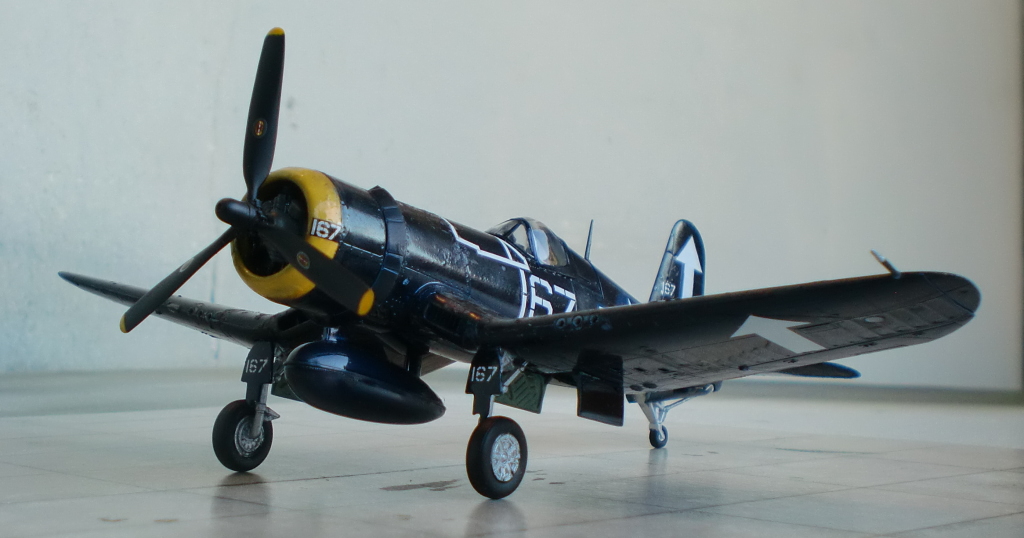

29/12/2016 Bell P-39 Airacobra Portuguese Air Force, Hobbyboss
What
American fighter design scored the most victories in WWII ? One would think
that it was the Mustang, or the Hellcat or Thunderbolt. But in fact it was
the Bell P-39 Airacobra, an aircraft that was considered a mediocre fighter
at best. And most of the victories were scored by the Russians, who used
this aircraft on lend-lease from the United States. Many Soviet aces scored
the majority of their kills in Airacobras.
The Beginning of the Airacobra was very different, however. Originally
designed as high altitude interceptor, aerodynamic refinements made it
necessary to remove the turbosupercharger from the engine (the Allison
V-1710). As a result, performance dropped dramatically over an altitude of
10.000 feet, making the Airacobra unsuitable in the classic fighter role –
the Western Allies used it primarly as a ground attack aircraft. But on the
Eastern Front, where air combat was taking place at much lower altitudes,
the Airacobra did quite well in the hand of the Soviets. They made a few
modifications, and at low altitudes it could compete quite well with the
German Bf 109 or Fw 190.
One reason for that was the powerful armament of the P-39, consisting of an
autocannon and four to six machine guns, depending on the version. The
aircraft was basically build around a single powerful weapons system, the
37mm M4 autocannon. Too heavy for a wing installation, the cannon was placed
in the nose of the aircraft, where it fired through the propeller hub. The
large cannon made it necessary to move the engine behind the cockpit, and
the propeller was driven by driveshaft running through the cockpit floor.
Another unusual feature (at the time) was the tricycle landing gear.
Although the M4 cannon was powerful, it was prone to jamming and most pilots
were not really impressed by the overall performance of the P-39. The Royal
Air Force received a batch of P-400 (the British version of the P-39) but
cancelled all following orders.
One of the lesser known operators of the P-39 was Portugal, as shown with
this model, depicting the P-39L OK-P of the “OK” Airacobra squadron in
Summer 1943. Portugal obtained these aircraft in a rather unusual way.
Between December 1942 and February 1943, 19 Airacobras (5 P-39 and 14 P-400)
had to make unscheduled landings in Portugal en route to North Africa.
Portugal, a neutral country in WWII, interned the aircraft and arrested the
pilots. After some talk on diplomatic channels, the Portuguese government
paid 20.000 $ for each aircraft to the United States and released the
pilots. In return, they received a few crates with Airacobra parts, but no
further spare parts or technical documents. Without manuals and spares, the
aircraft were somewhat difficult to operate and they did not see much flying
in the following years. The last remaining ones were sold for scrap in 1950.
This kit is one of the easy-build kits from Hobbyboss. Really nice and fun,
but as usual with them there are some inaccuracies. The P-39 had two
nose-mounted machine guns, on all versions, but not this kit. Weird as it is
supposed to be a P-39Q, the version build in the largest quantities. Decals
are from LF Models.

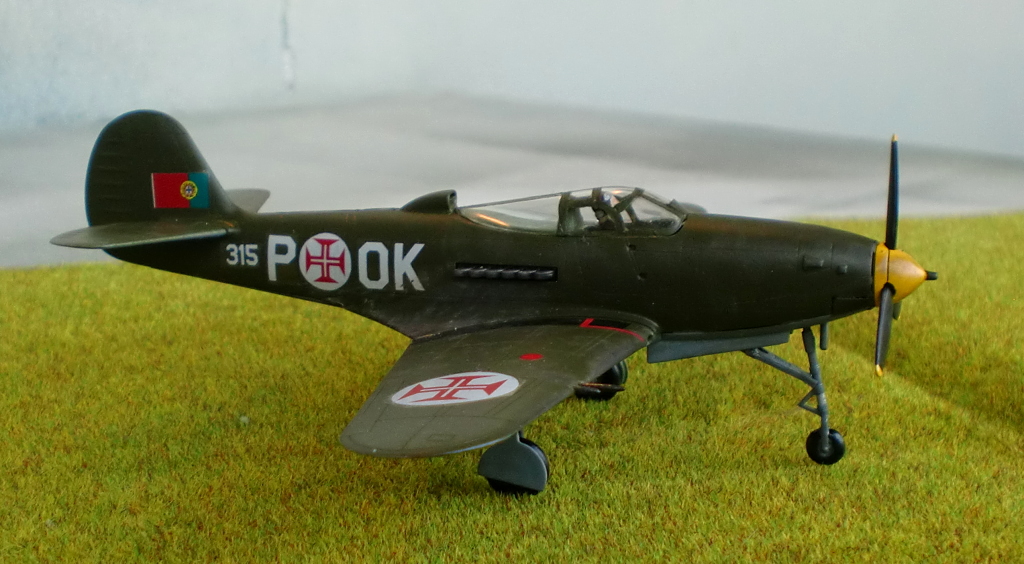

There are almost no pictures of the Portuguese Airacobras. Here are a few
P-400 in Royal Air Force camouflage with Portuguese markings:

22/12/2016 Grumman F4F Wildcat US Navy, Airfix
Two designs competed for
the first operational monoplane fighter aircraft of the US Navy, the
Brewster F2A Buffalo and the Grumman F4F Wildcat. The Buffalo won the
competition by a narrow margin but the Navy decided to allow Grumman
further development of the Wildcat, just in case to have a backup design
if necessary. Looking back now, this was a very wise decision as the
Buffalo proved to be a disaster in combat service and was soon replaced by
the Wildcat in US Navy and US Marines Corps Operations.
Although the Wildcat was a big improvement, performance-wise it was still
inferior to the Mitsubishi Zero in the Pacific War; however pilots felt
they had not really a disavantage if proper tactics were used. Soon
special aerial combat tactics were introduced by the Navy and when used
correctly, they could be used with great success against the Japanese
fighter. The Grumman had two advantages, it had superior firepower and was
a much tougher design compared to the Zero, allowing pilots return to
their carriers or bases even with heavy damage to the aircraft. When the
Hellcat was introduced as the primary Navy fighter in 1943, production of
the F4F was taken over by General Motor´s Eastern Aircraft division. The
stubby Wildcat was still needed for smaller escort carriers in the Pacific
and Atlantic, where the Wildcat´s smaller size and lower landing speed was
essential. In fact, the Wildcat was the only Navy fighter in production
during the entire length of WWII. It was also used by the Royal Navy,
where it was called the “Martlet”.
This Wildcat kit from Airfix is the F4F-4 version, the main differences
compared to the F4F-3 are foldable wings and six machine guns instead of
four. It belonged to VMF-223 and was flown by Captain Marion E. Carl
(1915-1998) of the US Marines Corps in 1942, based at Henderson Airfeld,
Guadalcanal (Solomon Islands). Carl was the first ace of the USMC and
finished the war as their seventh-ranking ace with 18,5 victories.
This newly-tooled Airfix kit is really a joy to build. It is even possible
to do a version with folded wings. I would say this is near Tamiya
quality, those new Airfix kits are really great and not too expensive. The
decals are from the kit, I used Vallejo airbrush colors and applied some
paint chipping and weathering. Overall a very fun build.




13/11/2016 Polikarpov I-16 Red Army Air Force, ICM Models
Introduced
in 1934, the Polikarpov I-16 was truly a revolutionary design. As the
world´s first all-metal monoplane fighter with retractable landing gear,
it was the “blueprint” for every other prop fighter design that followed
in the 1930s and 1940s. The I-16 had many nicknames, the Soviet pilots
called it “Ishak” (donkey) and in Spain it was called “Rata” (rat) and
this is the nickname most commonly associated with the I-16.
Designed for high speed and agility, the small and stubby I-16 was the
backbone of the Soviet Air Force until the German Invasion in 1941. In
the late 1930s, it was used with success by the Republican forces in the
Spanish Civil War, where it was the dominating fighter until the
Messerschmitt Bf 109 showed up. The Chinese Air Force used the I-16 in
the Sino-Japanese war where it was confronted with the latest Japanese
Designs – they were roughly equal.
The pilots generally liked the I-16 although it was difficult to fly and
relatively unstable (due to the short fuselage), but a skilled pilot
could use this for an advantage. In fact, many Russian ace pilots
started their careers in the “Rata”. However in 1941, when Germany
invaded the USSR, the I-16 was already outdated, the main disadvantage
against the Bf 109 was low speed. Many Soviet pilots at the time were
badly trained and losses were high, and so some pilots used aerial
ramming as a last resort. The I-16 had reinforced wings and the ramming
tactic was quite feared by the Germans. Production of the I-16 ended in
1942. There are still a few airworthy examples around, which is quite
rare for WWII Soviet warbirds.
The I-16 Type 10 fighter shown here was the personal aircraft of Major
General Ivan Alexeyevich Lakeyev in June 1941. A decorated Hero of the
Soviet Union, Lakeyev participated in the Spanish Civil War, the
Sino-Japanese War and WWII. He achieved ace status in Spain and during
WWII.
This kit is from Ukrainian manufacturer ICM and the decals are from
Printscale. ICM´s kit is the best detailed I-16 in 1/72 scale, although
I had mixed feelings about it. For such a small aircraft the kit is
overcomplicated and unnecessarly fiddly. It has complete engine detail
but this cannot be seen on the finished model as the cowling panels are
not really designed to be displayed open. The fit is suboptimal on many
parts. Nevertheless the final result is satisfactory, I think.
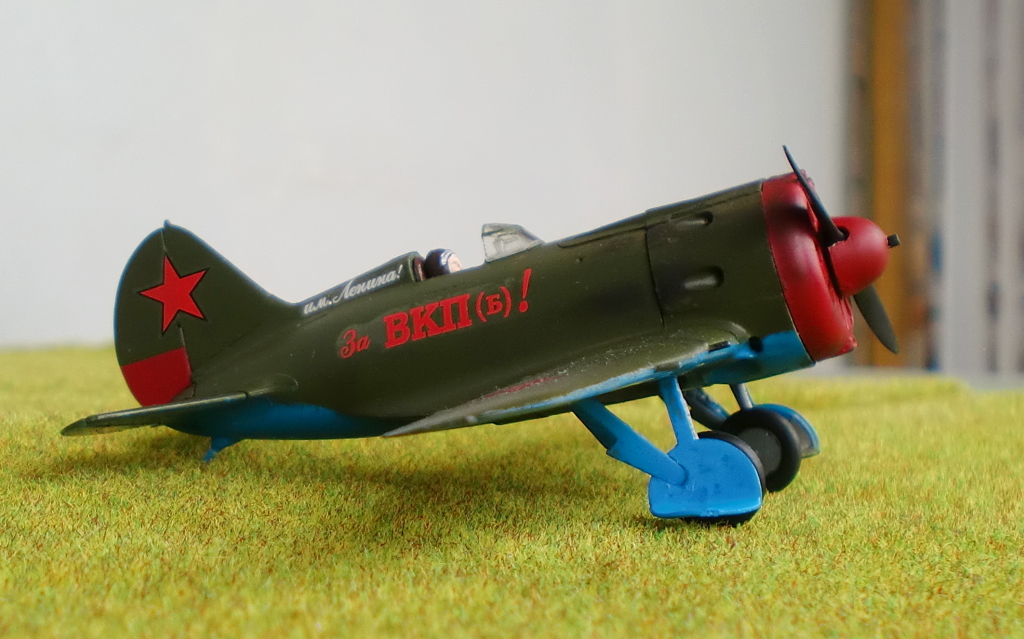

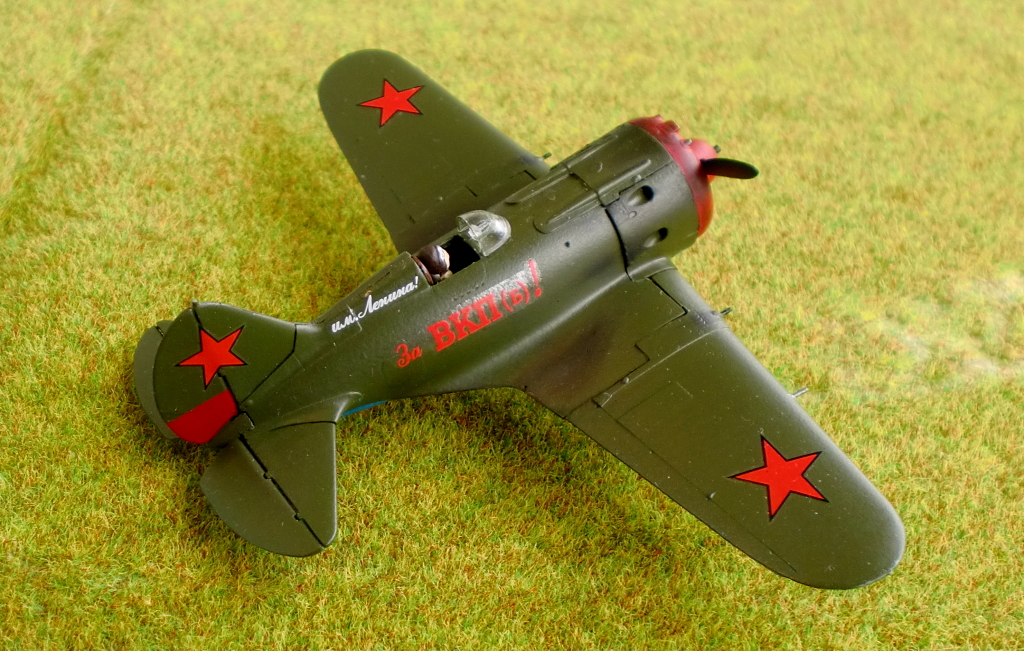

23/10/2016 Kokusai Ta-Go Kamikaze aircraft, Japanese Army Air Force,
Czechmaster Resin
As shown before in this thread, developing
purpose-build kamikaze aircraft was sort of a last resort for the
defense of the Japanese mainland. However, young officers of the Army
Air Technical Research Institute had an even more radical project in
mind. They proposed an extremely simple, easy to build aircraft that
could be build in large numbers with the limited resources of material
and manpower at hand at the time. Kokusai, a manufacturer of light
aircraft, agreed to build a prototype aircraft, although this was an
inofficial project without approval from the Japanese Air Force.
The prototype, the Kokusai Ta-Go (short for “bamboo spear”) was a
simple monoplane build entirely out of wood and powered by an 110hp
engine. Construction was extremely simplified so that this aircraft
could be build in small workshops with unskilled labour. To ease
construction, any sophisticated shapes or complex geometric forms in
the design were prevented. For example, the vertical and horizontal
tail surfaces were identical. It had foldable wings so it could be
hidden in tunnels, caves or even buildings. The only payload was
supposed to be a 100kg bomb under the fuselage. Flight performance was
considered not really important; the aircraft simply had to take off
for its single kamikaze mission.
The first and only prototype was test flown on June 25th, 1945. And
the story of the Ta-Go ends here – apparently the minimalistic design
caused handling problems and no series production was ever started.
What happened with the project after that is unknown – the Ta-Go
remains an obscure aircraft with little history, a design that truly
only could be conceived by the fanatical mindset of the time. What
could someone achieve with this machine ? It was underpowered, slow,
difficult to fly, an easy prey for any Allied aircraft and with it´s
wooden, unarmored construction, I suppose it could have being taken
down by hand guns at low altitudes.
The Ta-Go is so obscure, even short-run kit makers have not touched
this subject yet ! So I prepared to build my very first resin kit from
Czechmaster. It was a different experience compared to a
injection-molded plastic kit but quite enjoyable. Resin parts have to
be cleaned and filed first, and there are no fitting holes or other
building aids. Everything has to be done “free hand”, and glued
together by superglue, but this kit is relatively new and the parts
are finely detailed and of good quality. The kit had only around 20
parts, not that complex but the real aircraft wasn´t either. I added a
pilot figure to fill the otherwise empty cockpit. Could be a good
starterpoint for scratchbuilding the cockpit, but I did not bother
this time.


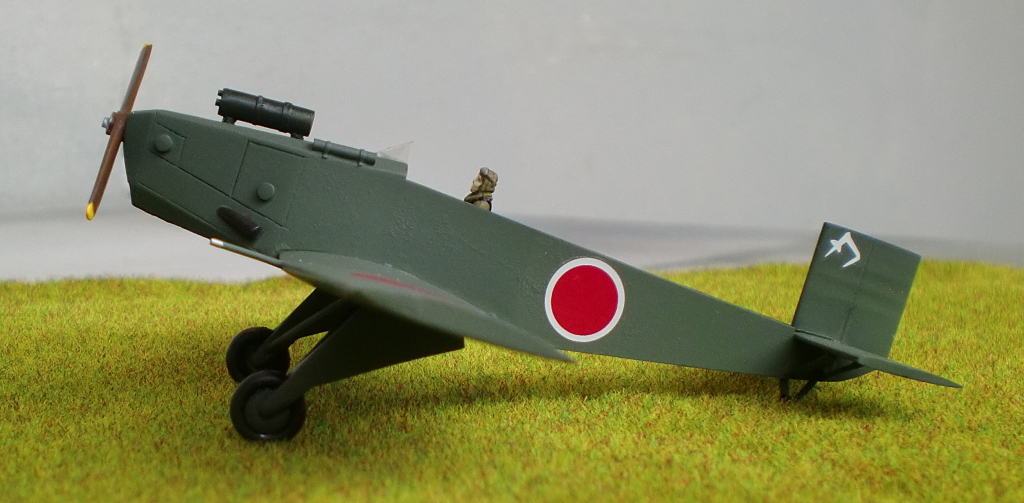
Only known picture of the prototype in flight:

05/10/2016 Henschel Hs 132A V1 prototype Luftwaffe, HUMA Models
When the Red Army captured an abandoned Henschel factory in Germany
during April 1945, they found a strange looking, almost completed
fuselage of a jet aircraft that was under development by the
Luftwaffe. It was the prototype of the Henschel Hs 132A V1, a
high-speed dive bomber and a planned sucessor of the Junkers Ju 87
“Stuka”.
The “Stuka” dive bomber was rather outdated during the last years of
WWII. The Luftwaffe, still convinced of the dive bomber concept,
ordered Henschel to develop a successor aircraft. One of the
requirements was high speed, so it emerged as a jet-engine powered
design. The 132A version was powered by a BMW 003 jet engine,
installed on top of the fuselage, with dihedraled vertical
stabilizers. It looked very similar to the Heinkel He 162
“Salamander”, a small fighter aircraft that entered service a few
weeks before the end of WWII. Between the short stubby wings was a
fuselage with a glazed nose. The production version of the Hs 132A
was unarmed, the only payload was supposed to be a 500kg bomb.
As the aircraft was expected to reach speeds of 570mph during a
dive, high g-loads of 10-12g were experienced during the pullout. To
cope with it, the pilot was lying prone in the cockpit while flying
the aircraft. Tests performed by the Germans in the 1930s had shown
that the human body could handle high g-loads in a prone position
much better than sitting.
Completion of the Hs 132A prototype was delayed a couple of times
when the factory had to move due to the ongoing Allied bombings. The
wings of the aircraft, assembled in France, were not delivered yet,
and the first flight was scheduled for June 1945. In the end the
aircraft never made a flight at all. The fuselage (and parts for
five other Hs 132 under construction) were captured by the Russians.
It is unknown what happened to these parts after the war.
Again an obscure aircraft, so it´s time for another short run kit !
The Hs 132 has been produced by HUMA of Germany in the 1980s and
there is a new tooling from RS Models. Remembering my experience
with the RS Models He 280, I choose the old HUMA kit, hoping it
would be a less “painful” kit to build. It was okay after all, not
quite detailed, and with a load of work to clean the parts up.
Another question was the paint scheme. As there never was a
completed aircraft one could only guess ! I choose a mix between
Aluminium and RLM prototype gray, as it could have looked like
straight from the workshop.



Incomplete fuselage of the first prototype:

05/09/2016 Heinkel He 51 Legion Condor, Hasegawa
The Treaty of Versailles
did not allow Germany to have an Air Force after WWI; however after the Nazis
gained power a secret development programme for military aircraft was
introduced. Some aircraft like the Heinkel He 111 were developed as civil
airliners but with military use in mind; others like the Heinkel He 51 fighter
were build from scratch to be used for military purposes only. The He 51
biplane was the standard fighter aircraft of the new emerging Luftwaffe for
the most part of the 1930s. It was later replaced by the Messerschmitt Bf 109.
Outdated as a front-line aircraft, it was used as a trainer during WWII.
The He 51 was used in combat during the Spanish Civil War between 1936-1939.
This conflict could be descriped as a prelude to WWII. Germany and Italy were
officially neutral in the conflict but supported the right-wing Nationalist
rebels commanded by General Franco; the left-wing Republican government was
supported by the Soviet Union. To support the Nationalists, Germany build up a
secret combat unit consisting of ground forces and air force units, called the
Condor Legion. Helping Franco was not the only reason for this operation; it
allowed Germany to test new aircraft and tactics in combat, namely the new Bf
109 and the Junkers Ju 87 “Stuka”. Lessons learned here helped the Luftwaffe
in improving their aircraft, crew training and tactics, and this also involved
the infamous bombing of Guernica, the first terror bombing of civilians in
history.
As a fighter, the He 51 initially performed well against the older, mostly
French-build aircraft of the Republicans, but when the Soviet Union delivered
the new Polikarpov I-15 and I-16 fighters, the days of the He 51 were numbered
as it was totally outclassed by these new machines. The He 51 was relegated to
the ground attack role, were it perfomed well until the end of the conflict in
1939.
This He 51 shown here was flown by the Commodore of 3/J88 fighter group, Adolf
Galland in 1938. Galland (1912 – 1996) was first trained as a ground attack
pilot but later signed on as a fighter pilot and did become an ace in WWII
with 104 victories and was later promoted to General of the fighter force.
Aged 29 he was the youngest General in the German forces. This He 51 was the
first of his aircraft featuring the distinctive Mickey Mouse logo on the
fuselage. This is an old Hasegawa kit build straight out of the box. It is
pretty basic and has few parts. I´m not the biggest fan of biplane kits and I
did not rigg the aircraft as this is a really nerve-wracking task. Not a bad
kit but unfortunately most of the decals started to disintegrate after
applying, maybe the just were too old.
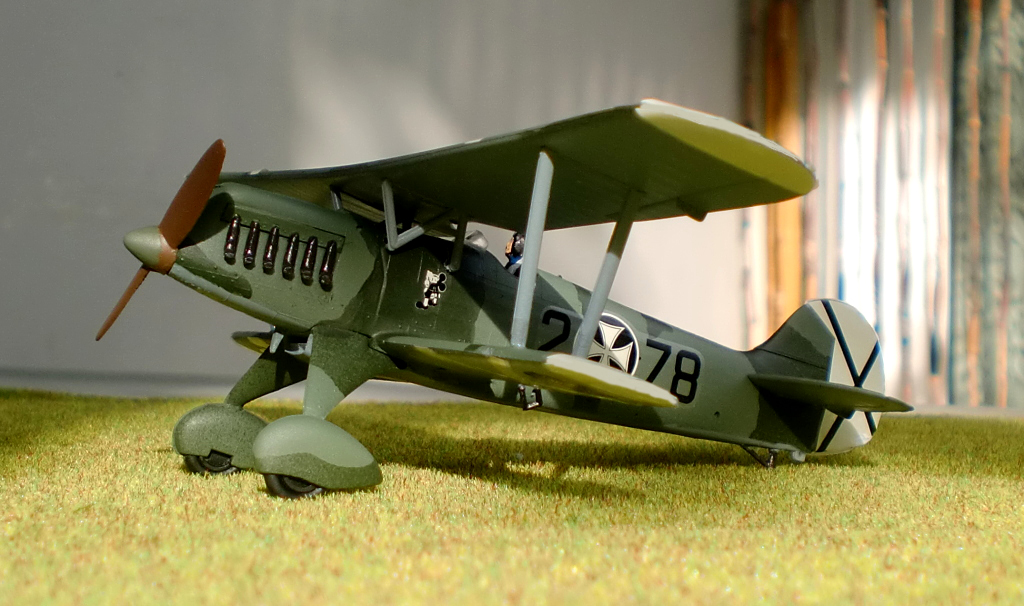

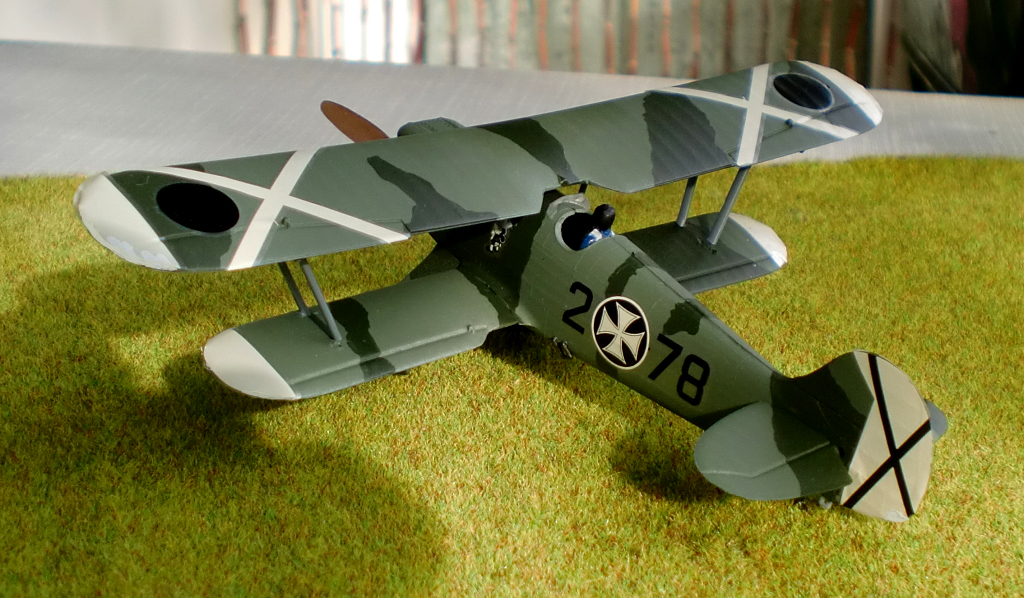
Adolf Galland (middle) in Spain

28/08/2016 Nakajima Kikka Imperial Japanese Navy, AZ Models
The development
of jet engines was lagging behind in Japan during early WWII; but a big
improvment was expected when Germany agreed to share technologies with the
Axis partner in the far East. In a secret operation, two Japanese U-boats with
technical personell, parts and blueprints left Germany in 1944, but both were
detected and sunk by the US Navy shortly before arrival in Japan and almost
all data was lost.
Nevertheless, the engineers at Ishikawajima, the engine manufacturer, started
with the little information they had on hand (mostly photographs and a few
drawings) and developed the first Japanese jet engine, the Ne-20. It was based
on the German BMW 003 engine design but was less powerful. A suitable
aircraft, the Kikka (“Orange Blossom”) was developed by Nakajima. It strongly
resembled the Messerschmitt Me 262 although the Kikka was much smaller and
more conventional in design. It had foldable wings so that the aircraft could
be stored in caves or tunnels as Japan was preparing for the defense of their
home islands.
Like the Me 262, the Kikka was supposed to be a multi-role aircraft, with
planned Interceptor and fighter-bomber versions. According to some sources it
was also a potential Kamikaze aircraft; although this is somehow disputed as
the aircraft (and especially the engines) were considered too complex and
expensive for a “one-way” mission.
The first (and only) test flight of the Nakajima Kikka was performed on August
7th, 1945 by test pilot Susumu Takaoka at Kisarazu airfield. Later the
aircraft was damaged during an aborted take-off but repairs could not be
completed – Japan surrendered on August 14th and the Kikka project was over,
with 10 incomplete airframes build. One fuselage remains and is stored at the
National Air and Space Museum in Washington D.C.
Another Czech short-run kit, this time from AZ Models. It represents the first
prototype in IJN colors as seen on the first test flight. A nice and little
kit, fiddly in parts as it can be expected for this kind of kit. Good to see
that nowadays you can really get all the odd models like this one – an
aircraft that only flew once and for about 10 minutes !
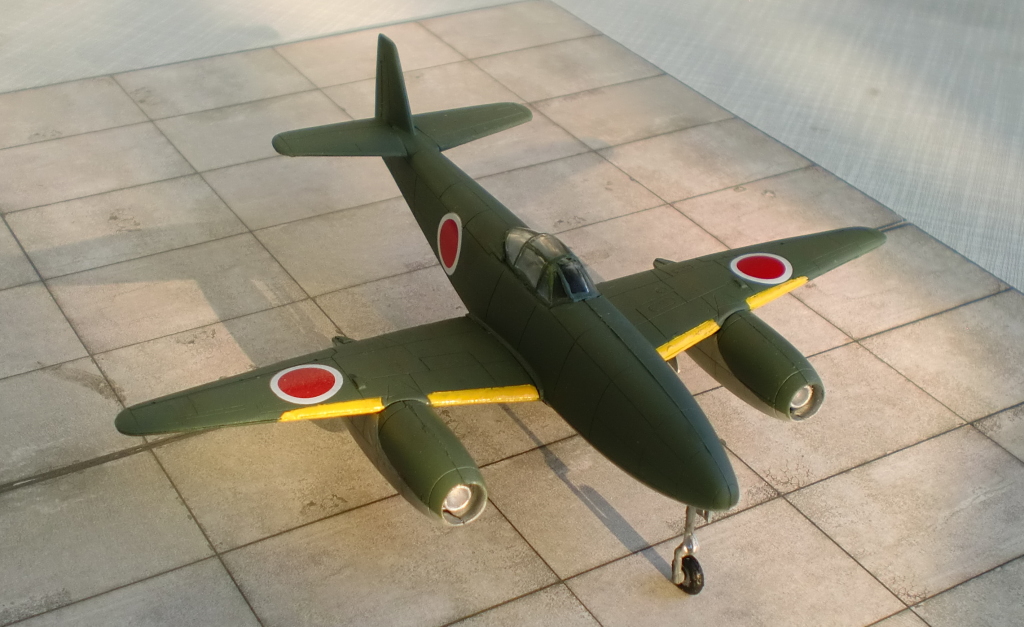



Back to page 2
To page 4

















































